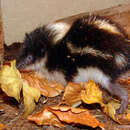Tenrecs (Family Tenrecidae)
provided by EOL authors
Tenrrecs are widely diverse, due to convergent evolution; various species resemble hedgehogs, shrews, opossums, mice and otters, but are not closely related to any of these groups. Their closest living relatives are African, insectivorous mammals such as golden moles and elephant shrews, which share a common ancestry with aardvarks, hyraxes, elephants, and sea cows in the group Afrotheria (3-9). All Madagascan species seem to have evolved from a single, common ancestor, with the mainland tenrecs comprising the next, most-closely related mammalian species (11,12). Some fossil specimens from the early Miocene of Kenya show close affinities to living species from Madagascar (13), such as Geogale aurita. The fossil record of tenrecids is relatively poor. The oldest known fossils are from the Miocene in East Africa and the Pleistocene in Madagascar, but the group is certainly considerably older. Recent molecular evidence (Murphy et al. 2001) suggests that they should be removed from the Insectivora and placed within a group of African mammals, the Afrotheria, which includes aardvarks, elephants, hyraxes, sea cows, elephant shrews, and golden moles as well as tenrecs. Tenrecs live in Madagascar and western central Africa and occupy aquatic, arboreal, terrestrial and fossorial environments. Some live in Madagascar's dry deciduous forests, while otter shrews live in fast-running streams of the African tropics. Tenrecs have radiated to include species that resemble, morphologically and ecologically, widely diverse mammals including hedgehogs, shrews, opossums, mice and otters. Tenrecs lack jugals, and their zygomatic arches are incomplete. Their tympanic bones are annular, and the squamosal contributes to the roof of the tympanic cavity. The dental formula varies consirably among species: 2-3/2-3, 1/1, 2-3/2-3, 2-4/2-3 = 32-40. The permanent dentition in tenrecs tends not to completely erupt until well after adult body size is reached (14). This features is shared by elephants, hyraxes, sengis and golden moles (but apparently not aardvarks), consistent with their descent from a common ancestor. The upper molars are zalambdodont, except in the otter shrews (Potamogalinae), where they are dilambdodont. The urogenital and anal apertures are included in a common opening or cloaca, a feature more commonly seen in birds, reptiles, and amphibians. The eyes are small. Many tenrecs do not maintain a constant body temperature, but let their bodies cool down while they are at rest. At least one species hibernates. Male tenrecids do not need a scrotum to cool their sperm as most other mammals do (2), so the testes remain within the body cavity. Most species are nocturnal and have poor eyesight. Their other senses are well developed and they have especially sensitive whiskers. During abnormally hot summer weather, tenrecs enter a state of inactivity, called aestivation and resembling hibernation. Before the start of the Austral winter (May-September), tenrecs eat more and lay down fat reserves in their bodies or tails before hibernating, which they usually do in burrows with the entrance plugged with soil. Madagascan winters are quite mild and could be termed the cool, dry season, but the vegetation and hence the food supplies, suffer from lack of rain and the tenrecs become dormant. Dormant tenrecs dug from their burrows are stiff and cold to the touch, have a very low breathing rate and lack food in the stomach or faeces in the intestine. When active, the body temperature that ranges from 75.2° F (24°C) to 95°F (35°C), much lower than most mammals.The body temperature of hibernating tenrecs is usually just 1.8° F (1°C) above the ambient temperature (17). This behaviour occurs with captive zoo specimens in countries with cooler average temperatures than their tropical Madagascan homeland (16). At least some species of tenrecs are social, living in multigenerational family groups with over 12 individuals. All species seem to be at least somewhat omnivorous, with invertebrates forming most the largest part of their diets. Tenrecs have a gestation period of 50-64 days and give birth to a relatively undeveloped young. Otter shrews have two young per litter, but the tailless tenrec has up to 29 teats and can have 32 young, more than other mammals (2). Some inhabitants of Mauritius eat tenrec meat. Subfamily Geogalinae: Large-eared tenrec (Geogale aurita) Subfamily Oryzorictinae: These small tenrecs lack spines. Most are shrew-like or mole-like, but Limnogale is aquatic. Some are highly fossorial. Web-footed tenrec (Limnogale mergulus); Short-tailed shrew tenrec (Microgale brevicaudata); Cowan's shrew tenrec (M. cowani); Dobson's shrew tenrec (M. dobsoni); Drouhard's shrew tenrec (M. drouhardi); Dryad shrew tenrec (M. dryas); Pale shrew tenrec (M. fotsifotsy); Gracile shrew tenrec (M. gracilis); M. grandidieri; Naked-nosed shrew tenrec (M. gymnorhyncha); Jenkins' shrew tenrec (M. jenkinsae); Northern shrew tenrec (M. jobihely); Lesser long-tailed shrew tenrec (M. longicaudata); M. macpheei (extinct); Major's long-tailed tenrec (M. majori); Montane shrew tenrec (M. monticola); Nasolo's shrew tenrec (M. nasoloi); Pygmy shrew tenrec (M. parvula); Greater long-tailed shrew tenrec (M. principula); Least shrew tenrec (M. pusilla); Shrew-toothed shrew tenrec (M. soricoides); Taiva shrew tenrec (M. taiva); Talazac's shrew tenrec (M. talazaci); Thomas's shrew tenrec (M. thomasi); Mole-like rice tenrec (Oryzorictes hova); Four-toed rice tenrec (O. tetradactylus) Subfamily Potamogalinae: Otter shrews are modified for an aquatic life and probably represent an early branch of the family. Nimba otter shrew (Micropotamogale lamottei); Ruwenzori otter shrew (M. ruwenzorii); Giant otter shrew (Potamogale velox) Subfamily Tenrecinae: These tenrecs are relatively large (up to the size of a cat) and highly variable in body form. All have spines, which are barbed and detachable in some forms and are controlled by a well-developed muscle, the panniculus carnosus. Tenrecines are mostly nocturnal and mostly omnivorous. Lesser hedgehog tenrec (Echinops telfairi); Highland streaked tenrec (Hemicentetes nigriceps); Lowland streaked tenrec (H. semispinosus); Greater hedgehog tenrec (Setifer setosus); Common tenrec (Tenrec ecaudatus)

